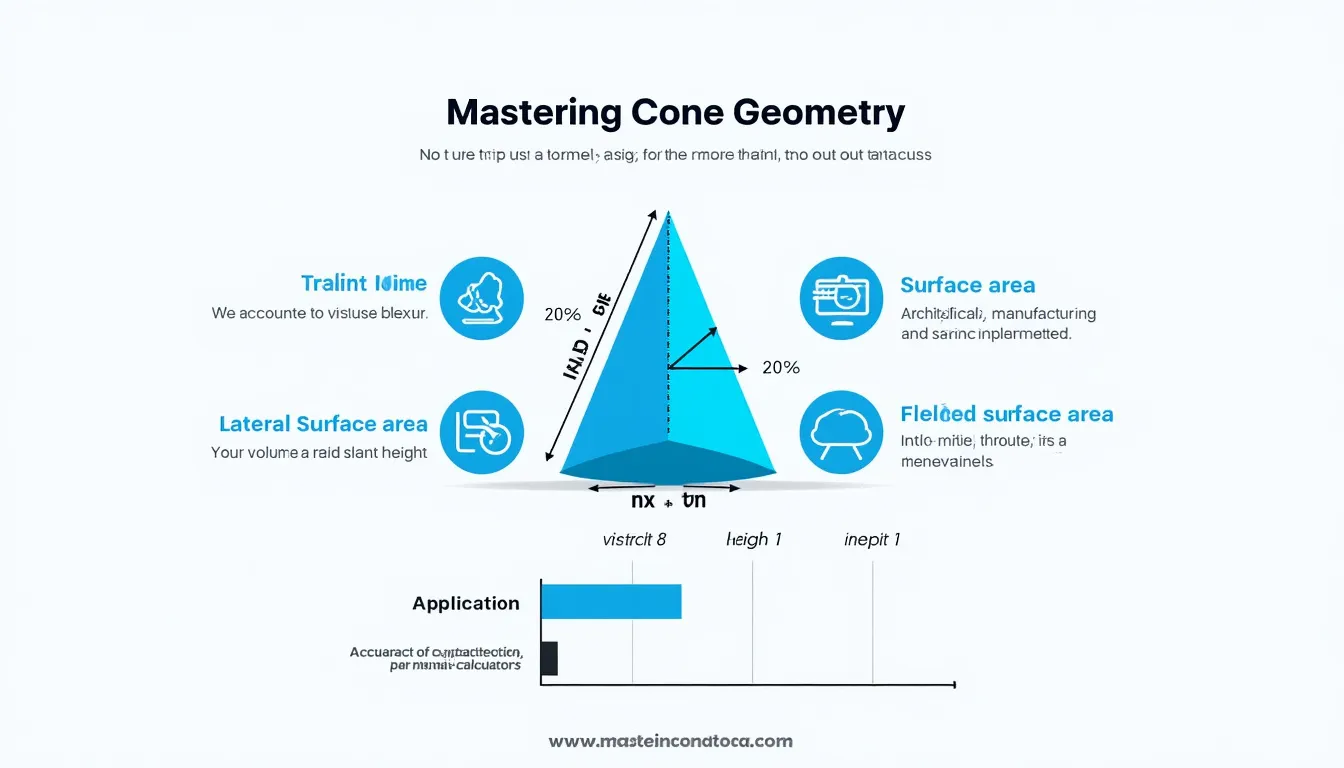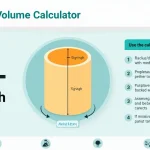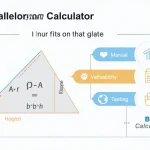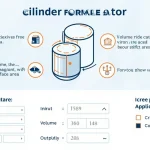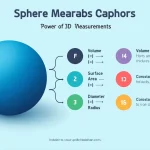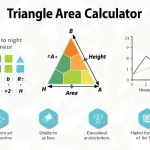Cone Calculator
Comprehensive Cone Calculator: Master Geometry with Ease
How to Use the Cone Calculator Effectively
Our Cone Calculator is designed to simplify complex geometric calculations, providing you with accurate results for various cone measurements. Follow these steps to make the most of this powerful tool:
- Enter the radius of the cone’s base in the “Radius” field.
- Input the height of the cone in the “Height” field.
- Click the “Calculate” button to generate results.
- Review the comprehensive output, including volume, surface area, diameter, lateral surface area, slant height, and base area.
Ensure that you input positive numbers for both radius and height to obtain accurate results. The calculator will display an error message if invalid inputs are detected.
Understanding Cones: Definition, Purpose, and Benefits
A cone is a three-dimensional geometric shape with a circular base that tapers to a single point called the apex or vertex. This shape is ubiquitous in both natural and man-made environments, from ice cream cones to volcanic formations. Understanding cone geometry is crucial in various fields, including mathematics, engineering, architecture, and design.
The purpose of our Cone Calculator is to simplify complex calculations associated with cone geometry. By automating these computations, we empower users to quickly and accurately determine essential measurements of a cone, saving time and reducing the likelihood of errors in manual calculations.
Key Benefits of Using the Cone Calculator
- Time-saving: Instantly calculate multiple cone measurements with a single click.
- Accuracy: Eliminate human error in complex mathematical calculations.
- Comprehensive results: Obtain a wide range of cone measurements in one go.
- User-friendly interface: Easy-to-use design suitable for students, professionals, and enthusiasts.
- Educational tool: Helps in understanding the relationships between various cone measurements.
The Mathematics Behind Cone Calculations
To fully appreciate the power of our Cone Calculator, it’s essential to understand the mathematical formulas used in cone geometry. Let’s explore each calculation in detail:
1. Volume of a Cone
The volume of a cone represents the amount of space it occupies. It is calculated using the formula:
$$V = \frac{1}{3}\pi r^2 h$$Where:
- V = Volume
- r = Radius of the base
- h = Height of the cone
2. Surface Area of a Cone
The surface area of a cone includes both the circular base and the curved lateral surface. It is calculated using the formula:
$$SA = \pi r(r + \sqrt{h^2 + r^2})$$Where:
- SA = Surface Area
- r = Radius of the base
- h = Height of the cone
3. Lateral Surface Area of a Cone
The lateral surface area represents only the curved surface of the cone, excluding the base. It is calculated using the formula:
$$LSA = \pi r\sqrt{h^2 + r^2}$$Where:
- LSA = Lateral Surface Area
- r = Radius of the base
- h = Height of the cone
4. Slant Height of a Cone
The slant height is the distance from the apex of the cone to any point on the circumference of its base. It is calculated using the Pythagorean theorem:
$$s = \sqrt{h^2 + r^2}$$Where:
- s = Slant height
- r = Radius of the base
- h = Height of the cone
5. Base Area of a Cone
The base area is simply the area of the circular base of the cone. It is calculated using the formula for the area of a circle:
$$A = \pi r^2$$Where:
- A = Base Area
- r = Radius of the base
Addressing User Needs and Solving Specific Problems
Our Cone Calculator addresses several user needs and solves specific problems related to cone geometry:
1. Educational Support
For students studying geometry, our calculator serves as an invaluable learning aid. It allows them to verify their manual calculations, understand the relationships between different cone measurements, and visualize how changing dimensions affect various properties of a cone.
2. Professional Applications
Engineers, architects, and designers often work with conical shapes in their projects. Our calculator streamlines their workflow by providing quick and accurate calculations for various cone properties, enabling them to make informed decisions in their designs.
3. Problem-Solving in Real-World Scenarios
The Cone Calculator can be applied to solve real-world problems involving conical shapes. For instance, it can help calculate the volume of a conical storage tank, determine the amount of material needed to cover a conical roof, or estimate the surface area of a conical filter.
4. Time-Saving for Complex Calculations
Manually calculating multiple properties of a cone can be time-consuming and prone to errors. Our calculator eliminates these issues by providing instant, accurate results for all relevant measurements simultaneously.
Practical Applications and Use Cases
To illustrate the practical utility of our Cone Calculator, let’s explore some real-world applications:
1. Architecture and Construction
Imagine an architect designing a conical roof for a building. They need to determine the amount of roofing material required and the volume of the space beneath the roof. Using our Cone Calculator, they can quickly input the base radius and height of the roof to obtain the lateral surface area (for material estimation) and volume (for space planning).
2. Manufacturing and Engineering
A manufacturing engineer is tasked with designing a conical funnel for a production line. They need to ensure the funnel has the correct volume capacity and surface area for optimal performance. By using our calculator, they can experiment with different dimensions to achieve the desired specifications efficiently.
3. Environmental Science
An environmental scientist studying erosion patterns in conical hills can use our calculator to estimate the surface area exposed to weathering. By inputting the measured radius and height of the hill, they can quickly obtain the surface area and other relevant measurements for their research.
4. Food Industry
A confectionery company wants to design a new ice cream cone. They need to determine the volume capacity of the cone and the amount of wafer material needed for production. Our Cone Calculator can provide these measurements instantly, helping in product development and cost estimation.
Frequently Asked Questions (FAQ)
1. What is the difference between surface area and lateral surface area?
Surface area includes both the curved surface of the cone and its circular base, while lateral surface area only accounts for the curved surface, excluding the base.
2. Can I use this calculator for truncated cones?
No, this calculator is designed for complete cones only. Truncated cones require different formulas and additional measurements.
3. Why do I need to know the slant height of a cone?
Slant height is useful in various applications, such as calculating the lateral surface area or determining the length of material needed to construct a conical shape.
4. How accurate are the results from this calculator?
Our calculator uses standard mathematical formulas and provides results to two decimal places. However, the accuracy of the output depends on the precision of the input values.
5. Can I use this calculator for homework or academic purposes?
Yes, you can use this calculator to check your work or understand cone geometry better. However, always follow your instructor’s guidelines regarding calculator use in academic settings.
6. Are the calculations valid for cones of any size?
Yes, the formulas used in this calculator are valid for cones of any size, as long as the input values are positive numbers.
Please note that while we strive for accuracy, we cannot guarantee that the webtool or results from our webtool are always correct, complete, or reliable. Our content and tools might have mistakes, biases, or inconsistencies.
Conclusion: Empowering Geometric Understanding
Our Comprehensive Cone Calculator is a powerful tool designed to simplify complex geometric calculations and enhance understanding of cone properties. By providing instant, accurate results for volume, surface area, lateral surface area, slant height, and base area, it serves as an invaluable resource for students, professionals, and enthusiasts alike.
Key benefits of using our Cone Calculator include:
- Time-saving automation of complex calculations
- Enhanced accuracy in geometric problem-solving
- Comprehensive results for multiple cone measurements
- User-friendly interface suitable for various skill levels
- Practical applications in education, engineering, and design
Whether you’re a student grappling with geometry homework, an engineer designing conical structures, or simply curious about the mathematics of cones, our calculator is here to assist you. By leveraging this tool, you can deepen your understanding of cone geometry, streamline your calculations, and approach cone-related problems with confidence.
We encourage you to explore the full potential of our Cone Calculator. Experiment with different dimensions, compare results, and discover how changes in radius or height affect various cone properties. By doing so, you’ll not only solve specific problems but also gain intuitive insights into the fascinating world of three-dimensional geometry.
Start using our Comprehensive Cone Calculator today and experience the power of efficient, accurate geometric calculations at your fingertips!
Is this tool helpful?
Important Disclaimer
The calculations, results, and content provided by our tools are not guaranteed to be accurate, complete, or reliable. Users are responsible for verifying and interpreting the results. Our content and tools may contain errors, biases, or inconsistencies. We reserve the right to save inputs and outputs from our tools for the purposes of error debugging, bias identification, and performance improvement. External companies providing AI models used in our tools may also save and process data in accordance with their own policies. By using our tools, you consent to this data collection and processing. We reserve the right to limit the usage of our tools based on current usability factors. By using our tools, you acknowledge that you have read, understood, and agreed to this disclaimer. You accept the inherent risks and limitations associated with the use of our tools and services.
